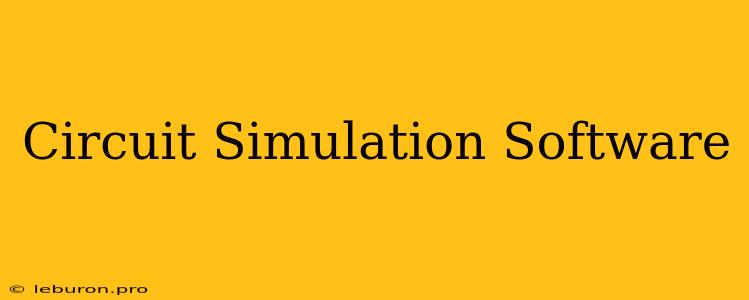Circuit simulation software has become an indispensable tool for electronics engineers, researchers, and hobbyists alike. It provides a virtual environment where users can design, analyze, and test electronic circuits without the need for expensive physical prototypes. This software offers a plethora of benefits, including cost reduction, time efficiency, and enhanced accuracy. In this article, we will delve into the world of circuit simulation software, exploring its functionalities, key features, and advantages.
What is Circuit Simulation Software?
Circuit simulation software is a type of computer program designed to simulate the behavior of electronic circuits. It uses mathematical models and algorithms to calculate the electrical characteristics of a circuit, such as voltage, current, power, and frequency response. By inputting the circuit design parameters, the software can generate accurate predictions of how the circuit will perform under various conditions.
How Circuit Simulation Software Works
The core of circuit simulation software lies in its ability to solve complex systems of equations that represent the circuit's behavior. This is achieved through numerical analysis techniques, such as the Newton-Raphson method or finite element analysis. The software takes the circuit schematic as input, which is usually drawn using a graphical interface. It then converts the schematic into a set of mathematical equations that describe the relationships between the components.
Key Features of Circuit Simulation Software
Circuit simulation software offers a range of features that make it a powerful tool for circuit design and analysis:
- Schematic Capture: Allows users to create circuit diagrams using graphical symbols for various electronic components.
- Component Libraries: Provides a wide selection of pre-defined components, including resistors, capacitors, inductors, transistors, operational amplifiers, and more.
- Circuit Analysis: Offers various simulation modes, such as DC analysis, AC analysis, transient analysis, and Fourier analysis, to study different aspects of the circuit's behavior.
- Waveform Visualization: Displays simulation results in graphical form, providing insights into voltage, current, and other parameters over time.
- Parameter Sweeping: Enables users to perform sensitivity analysis by varying component values and observing the impact on the circuit's performance.
- Optimization: Helps find optimal circuit configurations by automatically adjusting component values to meet specified performance criteria.
- Debugging: Identifies and diagnoses potential problems in the circuit design by analyzing simulation results.
- Integration with Other Tools: Allows users to seamlessly integrate the circuit simulation software with other design tools, such as printed circuit board (PCB) layout software.
Benefits of Using Circuit Simulation Software
Circuit simulation software offers numerous advantages for circuit design and development:
- Cost Reduction: Eliminates the need for expensive and time-consuming physical prototyping.
- Time Efficiency: Allows for faster design iterations and troubleshooting.
- Increased Accuracy: Provides precise predictions of circuit behavior, reducing the risk of errors during physical implementation.
- Flexibility and Experimentation: Enables users to explore different circuit designs and component variations without physical limitations.
- Enhanced Understanding: Provides a deeper understanding of the circuit's operation and its behavior under different conditions.
- Safety and Reliability: Allows for virtual testing of circuits in hazardous or potentially damaging environments.
Applications of Circuit Simulation Software
Circuit simulation software finds wide applications in various fields:
- Electronics Design: Used by engineers to design, analyze, and optimize electronic circuits for consumer electronics, industrial equipment, and aerospace applications.
- Research and Development: Employed by researchers in academia and industry to investigate new circuit concepts and develop innovative technologies.
- Education: Utilized by students and educators to learn about circuit theory and practical circuit design.
- Hobbyists: Employed by hobbyists to explore electronics projects and experiment with different circuit designs.
Choosing the Right Circuit Simulation Software
With a wide range of options available, choosing the right circuit simulation software for your specific needs is crucial. Factors to consider include:
- Complexity of the circuits you will simulate: Some software is better suited for simple circuits, while others can handle highly complex designs.
- Features required: Different software packages offer different features, such as advanced simulation modes, optimization algorithms, and integration with other tools.
- User interface and ease of use: Choose software that is intuitive and easy to learn and use.
- Cost: Consider the cost of the software and compare it to the benefits it offers.
Conclusion
Circuit simulation software has revolutionized the way we design and analyze electronic circuits. It provides a powerful and versatile platform for exploring circuit concepts, optimizing performance, and ensuring reliability. Whether you are an experienced electronics engineer, a budding researcher, or a passionate hobbyist, circuit simulation software can significantly enhance your work and enable you to create innovative and sophisticated electronic designs. By leveraging the capabilities of this technology, we can continue to push the boundaries of electronics and create groundbreaking solutions for a wide range of applications.
